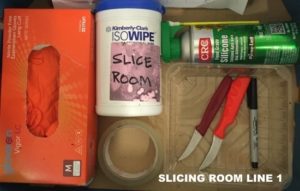Loose items stored within production area can easily become a foreign matter hazard if they are not controlled. Welcome to the HACCP Mentor series on Food Safety HACCP Compliance 101: How do I comply with that? Each week a compliance requirement of a piece of legislation, GFSI accredited standard or minimum food safety expectation will be reviewed. In this 101, controlled items are in the spotlight.
Why do we need a controlled items program?
The purpose of a controlled items program is to prevent any item from contaminating the food product. When we see a standard requirement that something needs to be controlled, it is saying that we need to make sure that items do not become a source of contamination within our food business. All of the GFSI recognized standards have a requirement to control items. Food safety legislation also stipulates that you must not contaminate food.
Examples of loose items
Every food production area is different, however one thing that is common is the types of loose items found in these areas. These loose items can include scissors, pens, tape, knives, labels and tools for fixing equipment or changing parts, labels, markers and scale weights.
Controlled items program
There are a few different ways that you can implement a controlled items program within your food business. The most common is to have a register or list of items. However, the easiest and most effective way that I have seen is to have a photographic register. Let me explain how to set this up.
1. Firstly, get a container with a lid (which can be easily cleaned) to store all of your loose items.
2. Lay out on a flat surface, all of the loose items that you want to store or have available within the production area.
3. Take a photograph of these items.
4. Print out this photograph on a piece of paper.
5. Write the names of the items and also the number of units next to each of the items on the photograph
6. Store this controlled items photographic register in the store container with the loose items. You can also have a copy on file.
Verifying controlled items
Now that you have the controlled items photographic register, you can easily check that items have been returned and there are no new items (uncontrolled items) floating around your food production area. You can also add a question to your pre-operational check form to record that the controlled items program has been effectively implemented.
How do you control your loose items?
If you have a different method that you use to control items within your food business please share with the HACCP Mentor community by leaving a comment below.
Level Up
If you are looking to level up your food safety, HACCP and quality knowledge, check out some of the training that is available. Click here to find out more.




Thanks Amanda for sharing this with us. Deeply appreciate your commitment in ensuring food safety for all.
Thanks Ehihumeme 🙂
To take a picture is more better than make a list because the picture will show visually and actual place it was kept. Thank you Amanda for showing us more insight. Regards
Thanks Alade!
Great idea to take a picture. Much easier than a list.
Way easier Angela 🙂 It also really helps if you have low literacy food handlers like some of my clients do. A picture tells a thousand words.
I really appreciate you guys. This is making such a difference. Kindest regards to all involved
Thanks Cedric! Glad to be of help.